I may cut a keiki off from a Dendrobium nobile and plant it. The original cane looks quite wrinkled and dried out, so maybe it's time. I think I'll do that now.
Showing posts with label Cattleya. Show all posts
Showing posts with label Cattleya. Show all posts
Sunday, July 18, 2010
orchid progress report
I may cut a keiki off from a Dendrobium nobile and plant it. The original cane looks quite wrinkled and dried out, so maybe it's time. I think I'll do that now.
Labels:
Cattleya,
Cattleya hybrid,
Oncidium,
orchids
Saturday, June 19, 2010
Minicattleya. Epicattleya "Landwoods"
I probably shouldn't keep it. We'll see how it does. If there is new growth that appears healthy, it may be worth trying to rebloom. I'll have to be careful to avoid any kind of cross-contamination if there is a possibility of virus.
Orchids starting new growth
Still at a stage where I don't know if orchids will grow for me at not. I've noticed that novices like myself look for signs of life frequently. Is it planning to bloom? Is it growing? They grow slowly, so it's easy to feel like they are almost inert. A sign of life is very rewarding.
 A few buds are starting to appear at bases of cattleya-type plants. New pseudobulb, but at this stage just buds. Still, they were not there before, so itlooks like this is a positive sign.
A few buds are starting to appear at bases of cattleya-type plants. New pseudobulb, but at this stage just buds. Still, they were not there before, so itlooks like this is a positive sign.
 A few more buds. Iwanagaara Appleblossom, a Potinara, and and a Brasolaeliocattleya are all showing some new growth buds.
A few more buds. Iwanagaara Appleblossom, a Potinara, and and a Brasolaeliocattleya are all showing some new growth buds.
 The next step, of course, is to nurture them into full size pseudobulbs, then to bloom.
The next step, of course, is to nurture them into full size pseudobulbs, then to bloom.
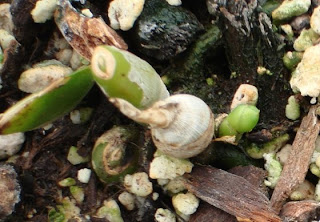 Also an interesting and positive sign. When I repotted a purchased Cattleya walkeriana, there was a second tiny plant, with one leaf and a few tiny pseudobulbs. I repotted it separately. Here it is, now with a new bud. The leaf fell off - I think it was ready to go anyway. We'll see if this bud grows into a larger pseudobulb than the existing ones.
Also an interesting and positive sign. When I repotted a purchased Cattleya walkeriana, there was a second tiny plant, with one leaf and a few tiny pseudobulbs. I repotted it separately. Here it is, now with a new bud. The leaf fell off - I think it was ready to go anyway. We'll see if this bud grows into a larger pseudobulb than the existing ones.
 Iwanagaara Appleblossom "Fantastic". Still blooming. I'm impressed at how long the flower lasts.
Iwanagaara Appleblossom "Fantastic". Still blooming. I'm impressed at how long the flower lasts.

Saturday, May 29, 2010
Potinara orchids, and related hybrids
I discussed Dendrobium, now something from the Cattleya alliance, Potinara. Another will be in the same shipment as Dendrobium Yellow Song Canary. The Potinara varieties seem suited for home culture, due to hybridization and small size.
Potinara is a manmade genus (nothogenus) created from several species of Cattleya-type orchids. Potinara consists of grandparents from Brassovola, Cattleya, Laelia, and Sophronitis.
It gets complicated. With genetic testing, some species have been moved to different genera, and some have been renamed. So... this is rephrased from Richard Pippen, Ph.D , Professor Emeritus, Western Michigan University, Naples, Florida
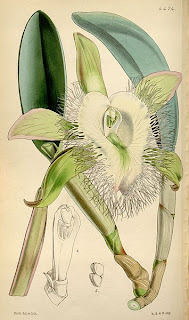 Some Brassasavola have changed. Now Brassavola digbyana is Rhyncholaelia digbyana. 19th century botanical sketch here is from Wikimedia commons. The Rhyncholaelia digbyana is a Mexican or Guatemalan species, and contributes larger, ruffled lip, and may contribute fragrance. from orchidspecies.com.
Some Brassasavola have changed. Now Brassavola digbyana is Rhyncholaelia digbyana. 19th century botanical sketch here is from Wikimedia commons. The Rhyncholaelia digbyana is a Mexican or Guatemalan species, and contributes larger, ruffled lip, and may contribute fragrance. from orchidspecies.com.
Other Brassovola parents were shuffled around, so some are now Brassocattleya or Brassocatanthe.
Rhyncholaelia provides fragrance and highly ruffled characteristics for the lip.
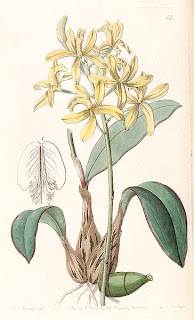 *Brazilian species of Laelia were merged into Cattleya.
*Brazilian species of Laelia were merged into Cattleya.
*Sophronitis was merged into Cattleya.
This drawing is "Sophronitis crispata as Laelia flava". How's that for confusing? " Laelia flava has brightly colored yellow, star-shaped flowers. Color ranges from yellow to pale yellow. Some individuals have small red spots near the base of the petals. The lip is frilly. The flower spike reaches 25 cm above the foliage and has 4 to 8 flowers near the tip." from verdantgreenla.orgI think these would contribute warm colors, yellow, orange, or red, and multiple flowers.
 *Cattleya auriantica, C. bowringiana, and C. skinneri were split out of Cattleya and are in the new genus Guarianthe. This sketch os Sophronitis coccinea as Sophronitis grandiflora. OK. The former Sophronitis coccinia, now Cattleya coccinia comes from Brazil. Info from mirandaorchids.com. Here we find red or orange coloration, clusters of flowers.
*Cattleya auriantica, C. bowringiana, and C. skinneri were split out of Cattleya and are in the new genus Guarianthe. This sketch os Sophronitis coccinea as Sophronitis grandiflora. OK. The former Sophronitis coccinia, now Cattleya coccinia comes from Brazil. Info from mirandaorchids.com. Here we find red or orange coloration, clusters of flowers.
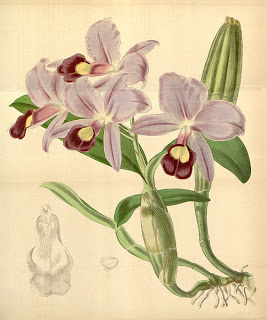 Guarianthe skinneri as Cattleya skinneri.
Guarianthe skinneri as Cattleya skinneri.
So Dr. Pippen gives the example, Potinara Burana Beauty, a cross between Potinara (now Rhyncattleanthe) Netrasiri Starbright and Cattleya Netrasiri Beauty, which went from
Brassavola x Cattleya x Laelia x Sophronitis = Potinara to Rhyncholaelia x Cattleya x Guarianthe = Rhyncattleanthe (Rth.)
Not that it is going to matter to the home grower - the species have been so jumbled, traits from multiple ancestors from multiple places contribute. See original link from Manatee Orchid Society for much more mind boggling detail. Where it matters to me, is that I like to look for the ancestors and see what the original plants looked like.
These are from HausermannOrchids.com and are the others in my order. Potinara"Cheryl Winkelman" Who knows what were the original progenitors, and with so much genetic scrambling, it may not be possible to find out. I find it compelling that the lip has a pattern similar to that seen on the Guarianthe skinneri sketch.
Potinara"Cheryl Winkelman" Who knows what were the original progenitors, and with so much genetic scrambling, it may not be possible to find out. I find it compelling that the lip has a pattern similar to that seen on the Guarianthe skinneri sketch.
 Sophrolaeliocattleya Jewelbox orange. Not Potinara, but with some members of the mix.
Sophrolaeliocattleya Jewelbox orange. Not Potinara, but with some members of the mix.
The photos don't show the entire plant, that will have to wait until I can do it myself. Assuming they survive and bloom in my hands.
Mor history of "Minicatts" here, from www.sdorchids.com.
Potinara is a manmade genus (nothogenus) created from several species of Cattleya-type orchids. Potinara consists of grandparents from Brassovola, Cattleya, Laelia, and Sophronitis.
It gets complicated. With genetic testing, some species have been moved to different genera, and some have been renamed. So... this is rephrased from Richard Pippen, Ph.D , Professor Emeritus, Western Michigan University, Naples, Florida
 Some Brassasavola have changed. Now Brassavola digbyana is Rhyncholaelia digbyana. 19th century botanical sketch here is from Wikimedia commons. The Rhyncholaelia digbyana is a Mexican or Guatemalan species, and contributes larger, ruffled lip, and may contribute fragrance. from orchidspecies.com.
Some Brassasavola have changed. Now Brassavola digbyana is Rhyncholaelia digbyana. 19th century botanical sketch here is from Wikimedia commons. The Rhyncholaelia digbyana is a Mexican or Guatemalan species, and contributes larger, ruffled lip, and may contribute fragrance. from orchidspecies.com.Other Brassovola parents were shuffled around, so some are now Brassocattleya or Brassocatanthe.
Rhyncholaelia provides fragrance and highly ruffled characteristics for the lip.
 *Brazilian species of Laelia were merged into Cattleya.
*Brazilian species of Laelia were merged into Cattleya.*Sophronitis was merged into Cattleya.
This drawing is "Sophronitis crispata as Laelia flava". How's that for confusing? " Laelia flava has brightly colored yellow, star-shaped flowers. Color ranges from yellow to pale yellow. Some individuals have small red spots near the base of the petals. The lip is frilly. The flower spike reaches 25 cm above the foliage and has 4 to 8 flowers near the tip." from verdantgreenla.orgI think these would contribute warm colors, yellow, orange, or red, and multiple flowers.
 *Cattleya auriantica, C. bowringiana, and C. skinneri were split out of Cattleya and are in the new genus Guarianthe. This sketch os Sophronitis coccinea as Sophronitis grandiflora. OK. The former Sophronitis coccinia, now Cattleya coccinia comes from Brazil. Info from mirandaorchids.com. Here we find red or orange coloration, clusters of flowers.
*Cattleya auriantica, C. bowringiana, and C. skinneri were split out of Cattleya and are in the new genus Guarianthe. This sketch os Sophronitis coccinea as Sophronitis grandiflora. OK. The former Sophronitis coccinia, now Cattleya coccinia comes from Brazil. Info from mirandaorchids.com. Here we find red or orange coloration, clusters of flowers. Guarianthe skinneri as Cattleya skinneri.
Guarianthe skinneri as Cattleya skinneri.So Dr. Pippen gives the example, Potinara Burana Beauty, a cross between Potinara (now Rhyncattleanthe) Netrasiri Starbright and Cattleya Netrasiri Beauty, which went from
Brassavola x Cattleya x Laelia x Sophronitis = Potinara to Rhyncholaelia x Cattleya x Guarianthe = Rhyncattleanthe (Rth.)
Not that it is going to matter to the home grower - the species have been so jumbled, traits from multiple ancestors from multiple places contribute. See original link from Manatee Orchid Society for much more mind boggling detail. Where it matters to me, is that I like to look for the ancestors and see what the original plants looked like.
These are from HausermannOrchids.com and are the others in my order.
 Potinara"Cheryl Winkelman" Who knows what were the original progenitors, and with so much genetic scrambling, it may not be possible to find out. I find it compelling that the lip has a pattern similar to that seen on the Guarianthe skinneri sketch.
Potinara"Cheryl Winkelman" Who knows what were the original progenitors, and with so much genetic scrambling, it may not be possible to find out. I find it compelling that the lip has a pattern similar to that seen on the Guarianthe skinneri sketch. Sophrolaeliocattleya Jewelbox orange. Not Potinara, but with some members of the mix.
Sophrolaeliocattleya Jewelbox orange. Not Potinara, but with some members of the mix.The photos don't show the entire plant, that will have to wait until I can do it myself. Assuming they survive and bloom in my hands.
Mor history of "Minicatts" here, from www.sdorchids.com.
Monday, May 10, 2010
Iwanagaara Appleblossom "Fantastic"
Wow - I'm impressed! Iwanagaara Appleblossom "Fantastic" didn't drop its buds, it bloomed! Nice flowers! No fragrance, but I have a cold and can't smell anything.
 It's more pale than the internet photo. Maybe it will darken, and develop fragrance, in a few days. From what I've read, the first day doesn't always have the fullest color and fragrance.
It's more pale than the internet photo. Maybe it will darken, and develop fragrance, in a few days. From what I've read, the first day doesn't always have the fullest color and fragrance.

This cold is miserable. Friday I felt crummy, Saturday I ignored it and did yard work, but not that much and it wore me out. Sunday I slept all day, and still felt crummy. Today I woke up feeling crummy. Maybe not as bad as yesterday. Will the blooming flower heal me?
It rained a little last night. Not a lot. The rain barrel filled up completely! That spout does drain half of the roof, so no surprise. But I was surprised, anyway.
Now I have an easy rainwater source for the orchids, and a quick water source for containers and seedlings. Cool! Now we're talking about getting a second one for increased storage capacity!
Thinning peaches and apples really gave them a boost! It's easy to compare fruit, tiny, on branches where I missed thinning, to fruit 4 times larger already, on the branches that I thinned. Apples not as dramatic as peaches.
This cold is miserable. Friday I felt crummy, Saturday I ignored it and did yard work, but not that much and it wore me out. Sunday I slept all day, and still felt crummy. Today I woke up feeling crummy. Maybe not as bad as yesterday. Will the blooming flower heal me?
It rained a little last night. Not a lot. The rain barrel filled up completely! That spout does drain half of the roof, so no surprise. But I was surprised, anyway.
Now I have an easy rainwater source for the orchids, and a quick water source for containers and seedlings. Cool! Now we're talking about getting a second one for increased storage capacity!
Thinning peaches and apples really gave them a boost! It's easy to compare fruit, tiny, on branches where I missed thinning, to fruit 4 times larger already, on the branches that I thinned. Apples not as dramatic as peaches.
Labels:
Cattleya,
Green living,
Iwanagaara,
orchid
Saturday, May 08, 2010
Cattleyas and Dendrobium
Two new additions. I keep saying I don't have room for more. That is correct. Still, during a hard week, it gives me something to look forward to.
I'm very impressed with Hausermann Orchids. This is my 3rd order from them - or is it the 4th? Each time, the plants were in great shape, carefully wrapped, nice root systems. This time, one was in bud, so if it doesn's suffer too much from shipping, and my treatment, I'll see flowers. That's very, very cool! I'm just very impressed.
 Here's the plant in bud, Iwanagara Appleblossom "Fantastic". This is also called Iwanagaara, and in some cases Apple Blossom is split into 2 words. Plus, with renaming, it may not even be Iwanagaara - I'll add more later. Regardless, it's said to be a versatile and fairly easy, compact, attractive, and fragrant.
Here's the plant in bud, Iwanagara Appleblossom "Fantastic". This is also called Iwanagaara, and in some cases Apple Blossom is split into 2 words. Plus, with renaming, it may not even be Iwanagaara - I'll add more later. Regardless, it's said to be a versatile and fairly easy, compact, attractive, and fragrant.
I repotted, as I have been doing when adding any orchids. Doing so gives me a chance to inspect the roots, trim off dead roots, convert to the same medium as the others, and transfer them into the pots with side openings. I almost didnt repot the Iwanagaara, due to the buds - but then decided to do so. Then sprayed with neem oil, as a 'tonic'.
 Iwanagaara Appleblossom "Fantastic". Picture from Hausermann orchids. I chose this variety because of the stated bloom time, and it was described as compact.
Iwanagaara Appleblossom "Fantastic". Picture from Hausermann orchids. I chose this variety because of the stated bloom time, and it was described as compact.
Can't forget, this Dendrobium nobile NOID is starting to bloom. Not the massive plant-hiding mass of flowers, but I think I like it better like this. It's the first Dendrobium that I've had bloom under my care, so that's cool.
I'm very impressed with Hausermann Orchids. This is my 3rd order from them - or is it the 4th? Each time, the plants were in great shape, carefully wrapped, nice root systems. This time, one was in bud, so if it doesn's suffer too much from shipping, and my treatment, I'll see flowers. That's very, very cool! I'm just very impressed.
I repotted, as I have been doing when adding any orchids. Doing so gives me a chance to inspect the roots, trim off dead roots, convert to the same medium as the others, and transfer them into the pots with side openings. I almost didnt repot the Iwanagaara, due to the buds - but then decided to do so. Then sprayed with neem oil, as a 'tonic'.
 Iwanagaara Appleblossom "Fantastic". Picture from Hausermann orchids. I chose this variety because of the stated bloom time, and it was described as compact.
Iwanagaara Appleblossom "Fantastic". Picture from Hausermann orchids. I chose this variety because of the stated bloom time, and it was described as compact.Can't forget, this Dendrobium nobile NOID is starting to bloom. Not the massive plant-hiding mass of flowers, but I think I like it better like this. It's the first Dendrobium that I've had bloom under my care, so that's cool.
Sunday, April 18, 2010
More orchid lithographs
 James Bateman was a landowner and horticulturalist, lived 1811-1897. He created the famous gardens at Biddulph with the aid of his friend and painter of seascapes Edward William Cooke. Bateman published the largest orchid book in his time. Most, but not all, lithographs on this page are from Bateman. All of these photos are from wikimedia commons.
James Bateman was a landowner and horticulturalist, lived 1811-1897. He created the famous gardens at Biddulph with the aid of his friend and painter of seascapes Edward William Cooke. Bateman published the largest orchid book in his time. Most, but not all, lithographs on this page are from Bateman. All of these photos are from wikimedia commons.Bateman's book is available here, at botanicus.org.
The lithographs are especially beautiful. Many show the entire plant, not just the decapitated flowers. The lithographs were as much about understanding the biology as they were about appreciating the beauty. Most orchids grow on tree branches, although there are nonepiphytic species, so drawings that include tree branches and exposed roots are more revealing and realistic than pictures of blossoms.
Bateman corresponded with Charles Darwin, who was fascinated by orchids (Darwin wrote a monograph on the ways that orchids interact with insects to ensure cross pollination). In January 1862 while researching insect pollination of orchids, Charles Darwin received a package of orchids from the distinguished horticulturist James Bateman, and in a follow up letter with a second package Bateman's son Robert confirmed the names of the specimens, including Angraecum sesquipedale from Madagascar.
The orchid explorers must have had a powerful sense of adventure. Those who grew them back in their own greenhouses, must have been happy to escape into their own world, as well. I think I understand, and would like that as well.
 Oncidium chrysothyrsus
Oncidium chrysothyrsus Oncidium insleayi or Rossioglossum insleayi
Oncidium insleayi or Rossioglossum insleayi Galeandra Baueri
Galeandra Baueri
Labels:
Cattleya,
Charles Darwin,
Dendrobium,
Oncidium,
orchid
A minicattleya
The leaves aren't the nicest looking, a bit mottled. I'm concluding that is often the case for orchids. The older leaves may well be 1 or 2 years old, possibly older. So they can't always be expected to be perfect.
On getting it home, I turned it out of the pot and cleaned off the roots. Compared to the Cattleya walkeriana, this plant had very healthy looking, plentiful, roots. I cut off a small number of dead-looking roots with a sterile scissors. I potted it back into the original container, but with fresh bark mix. Washed slightly warm water through the medium, then a watering of weak orchid supplement.
More:
I asked on gardenweb if anyone could identify this, orchid forum. They came back with Potinara Achung Yoyo "Little Goldfish". I'm certain that's the correct identification. Here's a google image search. It's identical. With the renaming of many potinaras, this may more correctly be a Rhyncattleanthe Ahchung Yoyo.
Tuesday, April 13, 2010
Orchid Lithographs
 These old lithographs are genuine treasures. They were published at a time when growing orchids was a hobby for the wealthy, who could grow them in their own greenhouses. The key as to which orchid is what, is here in Wikipedia.
These old lithographs are genuine treasures. They were published at a time when growing orchids was a hobby for the wealthy, who could grow them in their own greenhouses. The key as to which orchid is what, is here in Wikipedia..jpg) Epiphyte house at Knypersley-Bateman
Epiphyte house at Knypersley-Bateman
The above lithograph is by Ernst Heinrich Philipp August Haeckel , a German biologist, this photo 1860 from wikipedia.
 Haeckel and his assistant von Miclucho-Maclay Canary Islands, 1866. From Wikipedia, "an eminent German biologist, naturalist, philosopher, physician, professor and artist who discovered, described and named thousands of new species, mapped a genealogical tree relating all life forms, and coined many terms in biology, including phylum, phylogeny, ecology and the kingdom Protista. Haeckel promoted and popularized Charles Darwin's work in Germany and developed the controversial recapitulation theory ("ontogeny recapitulates phylogeny") claiming that an individual organism's biological development, or ontogeny, parallels and summarizes its species' entire evolutionary development, or phylogeny." Which is still taught today. Also typical for learned men of his time, he had generic ideas that we now rightfully consider racist. I like to think that, if he lived today, he would have seen those ideas as profoundly flawed, while expanding on his evolutionary studies.
Haeckel and his assistant von Miclucho-Maclay Canary Islands, 1866. From Wikipedia, "an eminent German biologist, naturalist, philosopher, physician, professor and artist who discovered, described and named thousands of new species, mapped a genealogical tree relating all life forms, and coined many terms in biology, including phylum, phylogeny, ecology and the kingdom Protista. Haeckel promoted and popularized Charles Darwin's work in Germany and developed the controversial recapitulation theory ("ontogeny recapitulates phylogeny") claiming that an individual organism's biological development, or ontogeny, parallels and summarizes its species' entire evolutionary development, or phylogeny." Which is still taught today. Also typical for learned men of his time, he had generic ideas that we now rightfully consider racist. I like to think that, if he lived today, he would have seen those ideas as profoundly flawed, while expanding on his evolutionary studies. I especially like the illustrations that show the entire plant, roots, stems, leaves, and flowers, such as this Laelia speciosa by Bateman, in 1840. This drawing is one of my favorites, showing the roots attached to a branch, and the elegant form of the plant and its flower.
I especially like the illustrations that show the entire plant, roots, stems, leaves, and flowers, such as this Laelia speciosa by Bateman, in 1840. This drawing is one of my favorites, showing the roots attached to a branch, and the elegant form of the plant and its flower. Oncidium micropogon, from Curtis's Botanical magazine, 1887. A typical drawing for the series. These drawings could be used to identify the plants, even today, as well as a photo. Somewhere, I read that the flowers resemble local bees, and that on seeing them tremble in the wind, a bee becomes agitated and attacks the 'foreign invaders'. This attack leads to transfer of pollen, ensuring the next generation. I don't know if this scenario is accurate, but I do see the resemblence.
Oncidium micropogon, from Curtis's Botanical magazine, 1887. A typical drawing for the series. These drawings could be used to identify the plants, even today, as well as a photo. Somewhere, I read that the flowers resemble local bees, and that on seeing them tremble in the wind, a bee becomes agitated and attacks the 'foreign invaders'. This attack leads to transfer of pollen, ensuring the next generation. I don't know if this scenario is accurate, but I do see the resemblence.My collection contains one plant similar to this variety, but the 'bee mimicry' is less obvious.
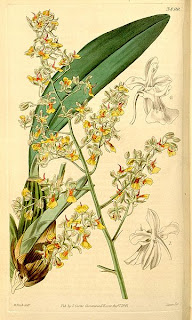 Oncidium longicornu, also from Curtis's Botanical magazine, 1842Any variety that I grow will doubtless be a hybrid, and also doubtless much easier to grow, compared to these freshly collected species plants. Even so, it's possible that my plants could be descended from these.
Oncidium longicornu, also from Curtis's Botanical magazine, 1842Any variety that I grow will doubtless be a hybrid, and also doubtless much easier to grow, compared to these freshly collected species plants. Even so, it's possible that my plants could be descended from these. Dendrobium nobile, from John Lindley's Sertum orchidaceum (1838-1841). Also from wikipedia, "It is one of the 50 fundamental herbs used in traditional Chinese medicine, where it has the name shí hú (Chinese: 石斛) or shí hú lán (Chinese: 石斛兰)."
Dendrobium nobile, from John Lindley's Sertum orchidaceum (1838-1841). Also from wikipedia, "It is one of the 50 fundamental herbs used in traditional Chinese medicine, where it has the name shí hú (Chinese: 石斛) or shí hú lán (Chinese: 石斛兰).".
Sunday, April 11, 2010
Orchid Blogging
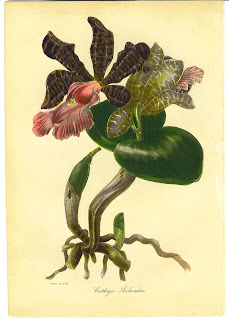 On Friday I received the new Blc. "Ports of Paradise" Emerald Isle, mentioned in previous blog entry. Beautiful plant, nice condition. Learning from prior failure-to-repot, I turned it out of the pot on Sat. am and repotted it in a glazed orchid-type pot with plentiful holes in the sides for air exchange. The majority of the roots looked great. All of the leaves were nice. The original medium was not rotted or soggy. Nice plant! Pic is an old lithograph, I believe that was from 1840s.
On Friday I received the new Blc. "Ports of Paradise" Emerald Isle, mentioned in previous blog entry. Beautiful plant, nice condition. Learning from prior failure-to-repot, I turned it out of the pot on Sat. am and repotted it in a glazed orchid-type pot with plentiful holes in the sides for air exchange. The majority of the roots looked great. All of the leaves were nice. The original medium was not rotted or soggy. Nice plant! Pic is an old lithograph, I believe that was from 1840s.I learned from gardenweb and internet sources, that waterspots can be cleaned off from orchid leaves using lemon juice. I just used lemon juice directly from a lemon-juice squeeze bottle, and wiped the leaves with paper towel. The leaves look clean, but not the super shiny leaves that result from leaf polishes. Nice info to know!
 I also looked for information on growing Dendrobium nobile, since I have 2 specimens. It seems they should do well here, just need to know when to water, when to feed, when to leave outside, and where to put them. It appears that the most important aspect is lots of sun. Today was high 60s outside, and overcast, so I set the dendrobiums outside for a while. Only about 3 hours, I didn't want them to sunburn. From my reading, looks like they need generous water and feeding until August, then change to low nitrogen feeding and cut back watering. Keep outside until nights drop into the 40s. Then keep dry until they show signs of growth again. Something like that. And as much sun as they can get, especially during Summer growth. Even direct sunlight, as long as they are watered frequently and not allowed to get sunburn. Scheme is from Yamamoto Dendrobiums, click for more readable scheme and better explanation.
I also looked for information on growing Dendrobium nobile, since I have 2 specimens. It seems they should do well here, just need to know when to water, when to feed, when to leave outside, and where to put them. It appears that the most important aspect is lots of sun. Today was high 60s outside, and overcast, so I set the dendrobiums outside for a while. Only about 3 hours, I didn't want them to sunburn. From my reading, looks like they need generous water and feeding until August, then change to low nitrogen feeding and cut back watering. Keep outside until nights drop into the 40s. Then keep dry until they show signs of growth again. Something like that. And as much sun as they can get, especially during Summer growth. Even direct sunlight, as long as they are watered frequently and not allowed to get sunburn. Scheme is from Yamamoto Dendrobiums, click for more readable scheme and better explanation.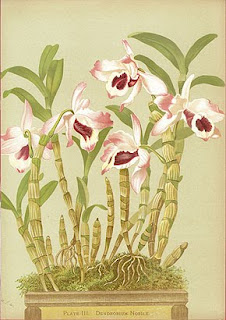 19th century print of a Dendrobium nobile. This is a cool arrangement - instead of a round plastc pot (plastic wasn't invented for, say, another hundred years), it's sort of a box or bonzai pot, with a tree-branch-like structure and moss, and the dendrobium growing as if in nature. I like the smaller number of flowers - some modern plants seem too lavish. I spent a fair amount of internet time determining that my plants were this species.
19th century print of a Dendrobium nobile. This is a cool arrangement - instead of a round plastc pot (plastic wasn't invented for, say, another hundred years), it's sort of a box or bonzai pot, with a tree-branch-like structure and moss, and the dendrobium growing as if in nature. I like the smaller number of flowers - some modern plants seem too lavish. I spent a fair amount of internet time determining that my plants were this species.
Thursday, April 08, 2010
Cattleya walkeriana alba
After promising myself that I would not add additional orchids after the last mentioned order, and especially from the grocery store, I walked past the orchid display at Trader Joes yesterday at lunch, saw the usual suspects, nothing jumped out at me. Then this one. Very nice in the store. I lost skepticism for about 15 minutes and bought it. Based on multiple web pics, it's Cattleya walkeriana alba, a Brazilian species, not a hybrid. Small size, wanders across the pot rather than being vertical. Likes the dry side.

Immediately on getting home, I unpotted. What a mess. There were actually 2 plants, but one with tiny pseudobulbs, and one small broken leaf. The other with the flower. There was a small vestige of original bark medium, but mostly soggy sphagnum, and about half of the roots were rotted.
I removed the old bark and sphagnum, trimmed off the rotted roots. I dipped the roots in a diluted solution of Dip'n'grow, a plant hormone that is used for rooting cuttings. That is a practice that some growers use for plants that need stimulation of rooting. I don't know if it will help. Then repotted in the same commercial medium that I've been using.
 Then I noticed this leaf. I hope this is just an old leaf, and bad growing practices. And I hope it's not a sign of virus infestation. I looked at many web pictures of virus infestation, and most don't look like this.
Then I noticed this leaf. I hope this is just an old leaf, and bad growing practices. And I hope it's not a sign of virus infestation. I looked at many web pictures of virus infestation, and most don't look like this.
I sprayed with neem, and this morning sprayed with a foliar feeding of dilute orchid food, same as the weakly weekly food. We'll see how they do, and I'll avoid using tools or containers for other plants, which is a good practice anyway
It's a nice little plant, and the flower is very nice as well, white with a pale green center. Interesting citrus fragrance. I hope it survives, grows, reblooms, and doesn't turn out to have virus. And it will be nice if the 2nd tiny plant grows, so I have one to share (You know who you are!).
Immediately on getting home, I unpotted. What a mess. There were actually 2 plants, but one with tiny pseudobulbs, and one small broken leaf. The other with the flower. There was a small vestige of original bark medium, but mostly soggy sphagnum, and about half of the roots were rotted.
I removed the old bark and sphagnum, trimmed off the rotted roots. I dipped the roots in a diluted solution of Dip'n'grow, a plant hormone that is used for rooting cuttings. That is a practice that some growers use for plants that need stimulation of rooting. I don't know if it will help. Then repotted in the same commercial medium that I've been using.
I sprayed with neem, and this morning sprayed with a foliar feeding of dilute orchid food, same as the weakly weekly food. We'll see how they do, and I'll avoid using tools or containers for other plants, which is a good practice anyway
It's a nice little plant, and the flower is very nice as well, white with a pale green center. Interesting citrus fragrance. I hope it survives, grows, reblooms, and doesn't turn out to have virus. And it will be nice if the 2nd tiny plant grows, so I have one to share (You know who you are!).
Saturday, April 03, 2010
Orchid blogging
It's been chilly and rainy all week. Not much to do outdoors - today I did mow the lawn, such as it is, for the first time.
The orchids came via UPS on Friday. See prior posting. The plants were in great shape, I'm very impressed with the appearance of the plants and with the care given to the packing. Hausermann orchids.
The link displays this Brassolaeliocattleya
The orchids came via UPS on Friday. See prior posting. The plants were in great shape, I'm very impressed with the appearance of the plants and with the care given to the packing. Hausermann orchids.
The link displays this Brassolaeliocattleya

The variety is "Ports of Paradise" Emerald Isle. Fragrant. May bloom twice a year.
I do not have room for more orchids, but I placed an order for a small one of this variety. I don't know how it will do here, so better not to spend too much. Something might have to go, to make room for it.
I repotted one Potinara and the Vaughnara. They were well potted. The Vaughnara was spilling out of its pot, and looks like it has some active growth, so it seems like a good moment to do so. The Potinara probably didn't need repotting, but I wanted to have it in a container with openings in the sides for better drying between waterings.
I also repotted the cymbidium - this had tough, healthy appearing roots encircling the medium in the container, difficult to separate. I also repotted a Phalaenopsis and a Paphiopedilum. In both cases, I realized that I should have repotted them on purchase. They had been grown in excessively moisture-retentive medium, then potted up in bark mix, then wrapped in spagnum. As a result, there were rotted roots. I cleaned them up, removed all old medium that I could, and potted into the new bark mix. We'll see.
Labels:
Cattleya,
orchid,
paphioledilum,
phalaenopsis
Saturday, March 27, 2010
A couple more orchids
The Oncidium back-bulbs that I collected last fall, have all sprouted now. The most recent was 1 week ago, about 1 cm of growth. In the hands of a total amateur(me), the ziplock-bag-with-sphagnum method works. It takes a lot of patience, but that's all.
I was looking at Cypripedium orchids, but at the cost not sure I can justify something so iffy. With the variable culture requirements, the tropicals are also iffy, but the reward of blooms during winter, and the long lasting flowers, give a better risk/benefit or cost/benefit profile for me.
I have wanted to add some Cattleya-type orchids, which are what I picture when I think "Orchid", despite knowing better. But Cattleyas are too large, and need too much sun, for my setting. With warmer weather, I can take a risk of a mail-orchid orchid, sitting outside for a few hours, when shipped, should be OK. The front of my house is not in the sun, so I don't think they'll cook, either.
These are from Hauserman Orchids.
 "Vaughnara Sir Walter Raleigh 'Yellow Squirt' (Bc. Daffodil x Epi tampense alba) - yellow, Compact-Under 15" Tall 2.5" pot size, Summer Bloomer". Here is another pic of the Vaughnara.
"Vaughnara Sir Walter Raleigh 'Yellow Squirt' (Bc. Daffodil x Epi tampense alba) - yellow, Compact-Under 15" Tall 2.5" pot size, Summer Bloomer". Here is another pic of the Vaughnara. "Potinara Free Spirit 'Eric' (Twenty Four Carat x Sc. Beaufort) - mini yellow, Winter bloomer Miniature-Under 12" Tall, 4" Pot Size on Special!" According to the "Miracle-Gro Complete Guide to Orchids", Potinara is "sympodial, compact, likes medium to bright, indirect light; mild nights, warm days, moderate humidity; let dry between waterings." The book goes on to state, "The growth habit and growing needs... are similar to those of other cattleya hybrids, but their sophronitis background makes them slightly smaller. Cylindrical pseudobulbs are topped with one or two succulent leaves." The 2 varieties that are listed are described as having easy culture but "Free Spirit" isn't listed in the reference.
"Potinara Free Spirit 'Eric' (Twenty Four Carat x Sc. Beaufort) - mini yellow, Winter bloomer Miniature-Under 12" Tall, 4" Pot Size on Special!" According to the "Miracle-Gro Complete Guide to Orchids", Potinara is "sympodial, compact, likes medium to bright, indirect light; mild nights, warm days, moderate humidity; let dry between waterings." The book goes on to state, "The growth habit and growing needs... are similar to those of other cattleya hybrids, but their sophronitis background makes them slightly smaller. Cylindrical pseudobulbs are topped with one or two succulent leaves." The 2 varieties that are listed are described as having easy culture but "Free Spirit" isn't listed in the reference.Both varieties are yellow. One of these days I'll locate a green miniCattleya, or white, and add that as well.
Here is the Vaughnera, pictured on the Orchid Board. Vaughnera is Brassavola X Cattleya X Epidendrum.
Potinara is Brassavola x laelia x cattleya x sophronitis
The vast majority of locally available orchids are Phalaenopsis, or Oncidium hybrids, with some Paphiopedilum, Dendrobium, and Cypripedium hybrids thrown in. So far I haven't seen many miniCattleya hybrids, and the small number I've seen didn't appeal to me (shades of pink and purple, or splotchy flowers). With mail order, the options are more variable, although there's more risk in other ways - will they be what I order, will they be healthy, will they bloom? I imagine these will be small, and I don't know if they will bloom this year. It's all a gamble. I'll be happy if a few of the others rebloom this year, and if most of them grow and thrive.
Labels:
back-bulbs,
Cattleya,
Dendrobium,
Oncidium,
orchid
Subscribe to:
Posts (Atom)


